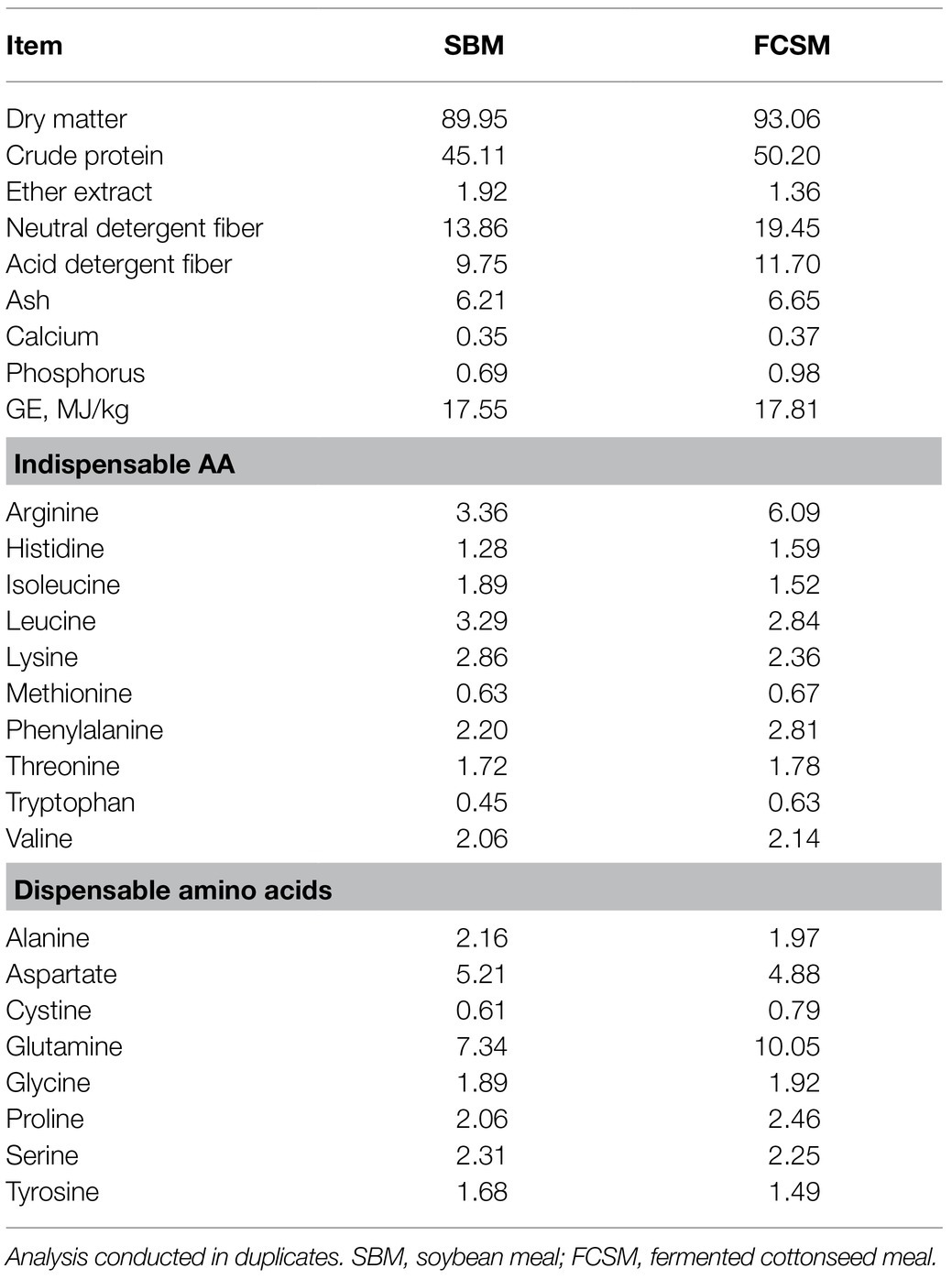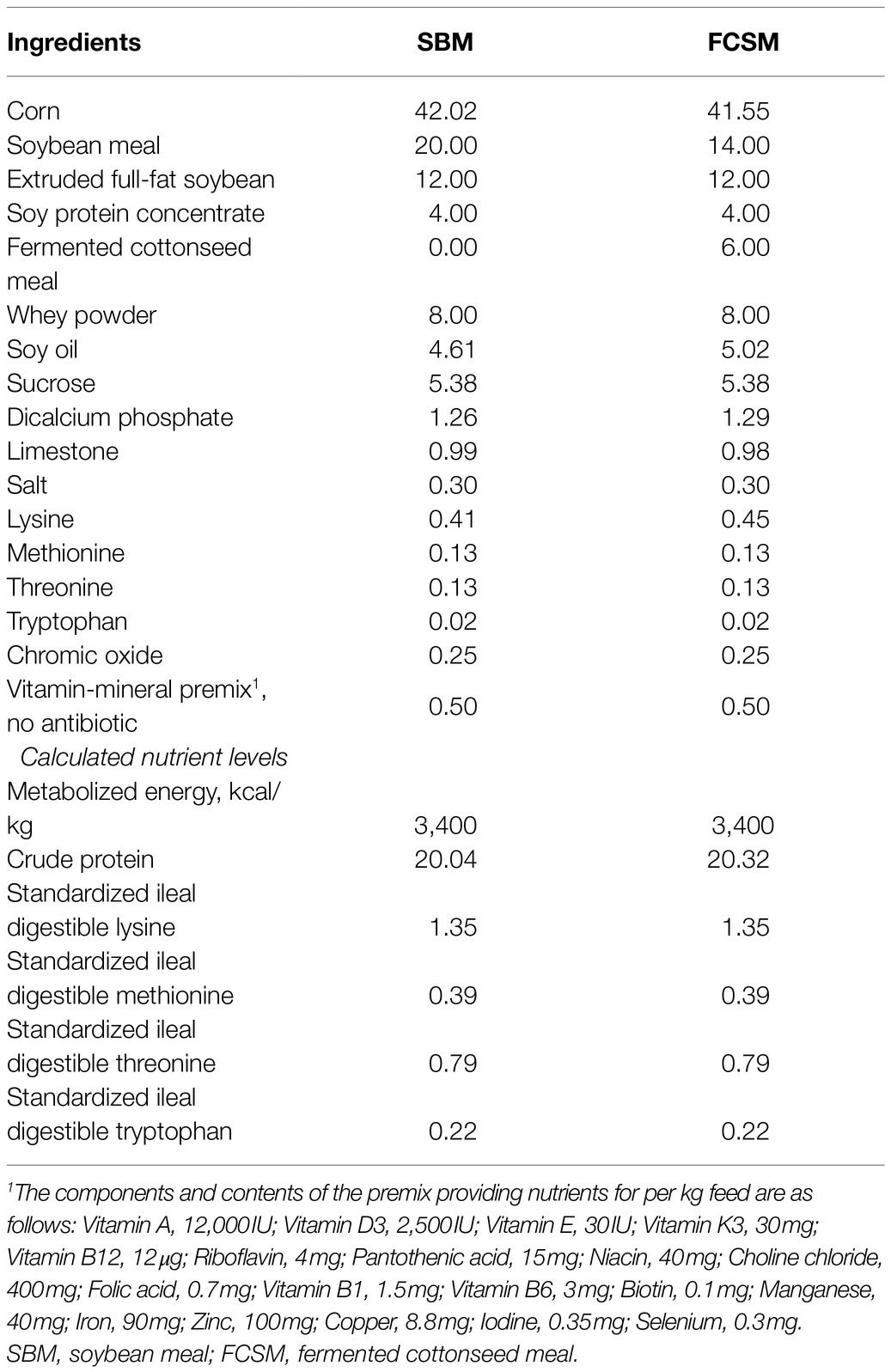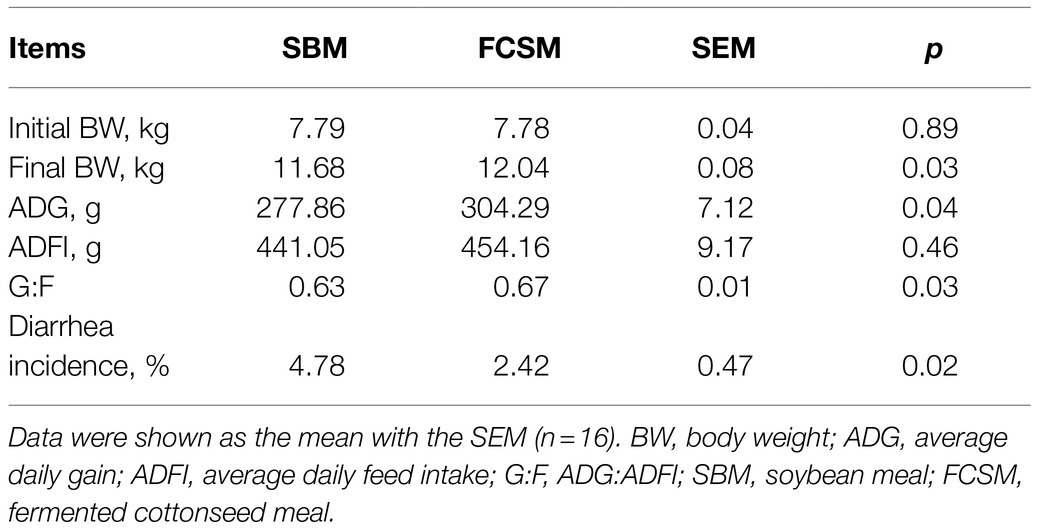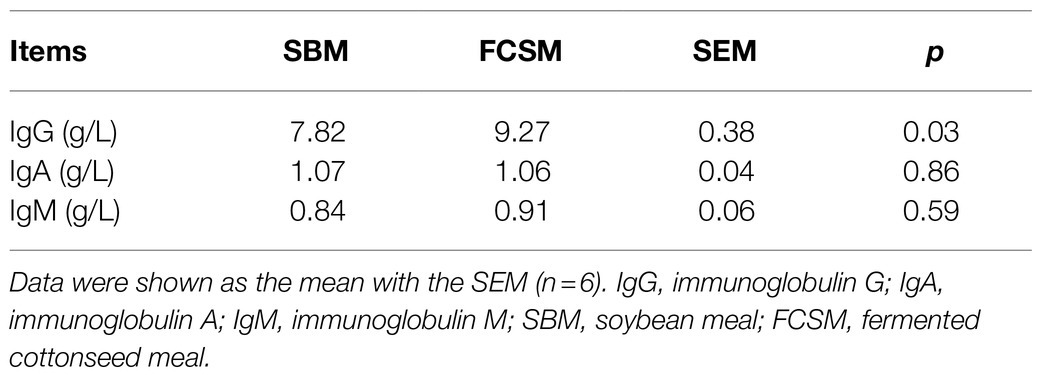- College of Animal Science and Technology, Hunan Agricultural University, Changsha, China
The study investigated the impact of fermented cottonseed meal (FCSM) on growth performance, immunity and antioxidant properties, nutrient digestibility, and gut microbiota of weaned piglets by replacing soybean meal with FCSM in the diet. The experimental piglets were fed with either the soybean meal diet (SBM group) or fermented cottonseed meal diet (FCSM group) for 14days after weaning. The digestibility of dry matter (DM), organic matter (OM), crude protein (CP), gross energy (GE), amino acids and nitrogen was higher in the FCSM diet than those in the SBM diet (p<0.05). The piglets in the FCSM group showed greater growth performance and lower diarrhea rate than those in the SBM group (p<0.05). The concentration of serum immunoglobulin G (IgG) and antioxidase, intestinal and hepatic antioxidase were increased and the concentration of malondialdehyde (MDA) in the serum was decreased in those piglets in the FCSM group compared to those piglets in the SBM group (p<0.05). The piglets in the FCSM group had a higher concentration of volatile fatty acids (VFAs) in their ileum and cecum and a higher Simpson index of ileum than piglets in the SBM group (p<0.05). The relative abundance of Lactobacillus and [Ruminococcus]_torques_group in ileum and Intestinibacter, norank_f_Muribaculaceae, unclassified_o_Lactobacillales and [Eubacterium]_coprostanoligenes_group in cecum were enhanced in piglets fed with the FCSM diet, whereas the relative abundance of Sarcina and Terrisporobacter were increased in piglets fed with the SBM diet. Overall, FCSM replacing SBM improved the growth performance, immunity and antioxidant properties, and nutrient digestibility; possibly via the alterant gut microbiota and its metabolism of weaned piglets.
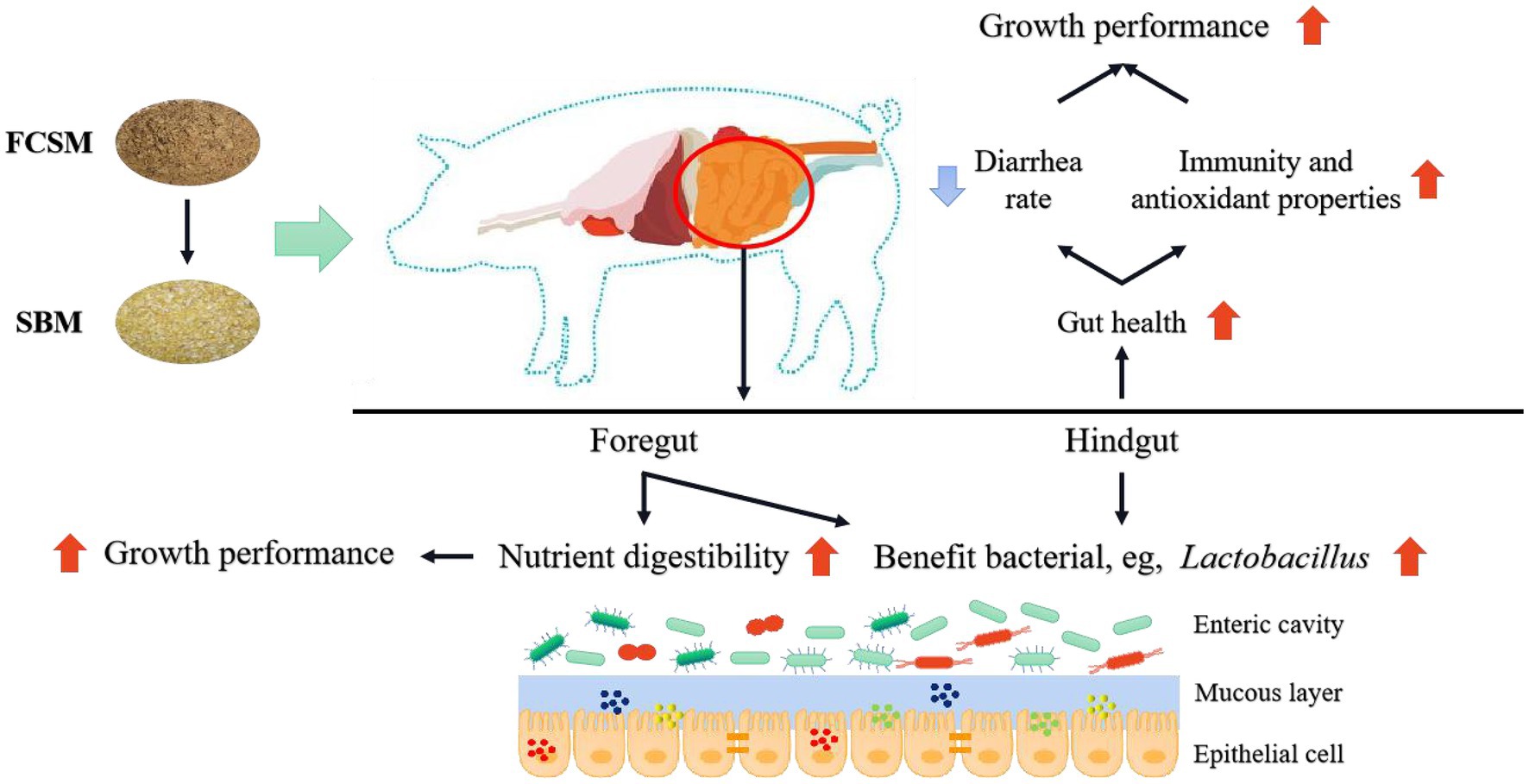
Graphical Abstract. Fermented cottonseed meal as a partial replacement for soybean meal could improve the growth performance, immunity and antioxidant properties, and nutrient digestibility by altering the gut microbiota profile of weaned piglets. SBM, soybean meal; FCSM, fermented cottonseed meal.
Fermented cottonseed meal as a partial replacement for soybean meal could improve the growth performance, immunity and antioxidant properties, and nutrient digestibility by altering the gut microbiota profile of weaned piglets. SBM, soybean meal; FCSM, fermented cottonseed meal.
Introduction
Soybean meal (SBM), an important protein source in the livestock industry, is highly recognized for its significant protein content and widespread availability (Azarm and Lee, 2014; Kim, 2014). However, the price of SBM has increased dramatically and the supply of high-quality protein feeding ingredients (such as SBM and fish meal) has been deficient in recent years. This leads to a higher livestock breeding expense and restricts the development of animal husbandry. Therefore, there is an urgent need for more alternative high-quality protein feeding ingredients to solve the protein source crisis in animal husbandry.
Cottonseed meal (CSM), a by-product obtained from the process of extracting the oil from cotton seed, is an attractive alternative protein source for livestock diets (Nagalakshmi et al., 2007). However, compared to SBM, the application of CSM as a feed ingredient in animal husbandry is limited due to the presence of anti-nutritional factors (Lordelo et al., 2007; Tang et al., 2012) such as free gossypol, cycloproponoic fatty acids, and crude fiber, which may cause negative effects on growth performance and organ functionality (Nie et al., 2015; Świątkiewicz, 2016). Fermented cottonseed meal (FCSM), a product produced by mixing solid CSM with liquid phases and then inoculating the mixture with beneficial microorganisms (Sun et al., 2014), can reduce free gossypol and improve the protein quality of CSM with solid state fermentation (Zhang et al., 2007). It has been suggested that the FCSM partial replacing SBM (about 6–8%) not only can improve the growth performance, immune and antioxidant capacity, and digestibility in broiler chickens (Sun et al., 2013; Nie et al., 2015; Wang et al., 2017; Niu et al., 2020), but also can reduce the F:G (the ratio of feed and gain weight) and diarrhea rate in nursery pigs, growing pigs and finishing pigs (Guan et al., 2017), which indicated that the FCSM has the potential to be a high-quality protein source.
Weaned piglet is a critical group in whole pig production, which consumes a large amount of high-quality protein ingredients. However, there is a lack of relevant research on the application of FCSM in weaned piglets. Therefore, the present study aimed to compare the effects of dietary SBM and FCSM on growth performance, immunity and antioxidant properties, nutrient digestibility, and gut microbiota of weaned piglets.
Materials and Methods
The animal handling and all procedures of this study received approval from the Animal Care and Use Ethics Committee of the Hunan Agricultural University (Changsha). The FCSM used in this experiment was provided by the Tycoon Group (Xinjiang, China). The SBM used in this experiment was provided by Hunan Lifeng Biological Technology Co., Ltd. (Hunan, China). Table 1 shows the nutrient composition of SBM and FCSM.
Animal Treatment and Experimental Design
A total of 32 Duorc×(Landrace×Yorkshire) growing barrows, with an average initial body weight (BW) of 7.85±0.49kg, were allotted to two dietary treatments in a completely randomized design with 16 repetitions per treatment according to their body weight. The dietary treatments include SBM diet and FCSM diet: the FCSM diet was formulated by adding 6% FCSM to replace the SBM compared with the SBM diet, and corn and soy oil was changed to balance the energy and protein levels (Table 2). The experimental diets and vitamin-mineral premix were configured to meet the nutritional needs of nursery piglets as recommended by the NRC (2012). The experimental period lasted for 14days. The house, feed trough and drinker were thoroughly cleaned and disinfected before starting the experiment. The temperature of the pig house was kept at 24–28°C, and the relative humidity was controlled at 60–70%. All the pigs were provided ad libitum access to water and feed. The daily feed intake and BW of each pig were recorded on day 0 and day 14 to calculate the average daily gain (ADG), average daily feed intake (ADFI) and feed conversion rate (ADG:ADFI, G:F). A scoring system was applied to indicate the presence and severity of diarrhea as following: 1=hard feces; 2=slightly soft feces; 3=soft, partially formed feces; 4=loose, semiliquid feces; and 5=watery, mucous-like feces.
Sample Collection
By the end of the experiment, six samples of blood (10ml) were collected from the precaval veins of each group of piglets after fasting for 12h. After standing the blood samples for 1h at 4°C, they were centrifuged at 3,000×g for 15min at 4°C, whereupon the serum samples obtained were immediately stored at −80°C for immunoglobulin and antioxidant indices analysis including immunoglobulin A (IgA), immunoglobulin G (IgG), immunoglobulin M (IgM), superoxide dismutase (SOD), glutathione peroxidase (GSH-Px), total antioxidant capacity (T-AOC), and malondialdehyde (MDA). After the blood collection, six piglets closest to the average BW from each group were slaughtered, and then the jejunum, ileum and liver, were sampled through a sterile laparotomy, which was collected in centrifuge tubes and immediately placed in liquid nitrogen and then stored at the temperature of −80°C for analysis of antioxidant indices levels of SOD, GSH-Px, catalase (CAT), T-AOC and MDA in jejunal, ileal and liver tissue. Besides, the ileum and cecum segments were isolated to collect the digesta samples using centrifuge tubes and a part of them immediately placed in liquid nitrogen and then stored at the temperature of −80°C for analysis of microbiome and metabolite. The rest of samples were stored at −20°C for subsequent chemical composition analysis to calculate nutrient digestibility.
Determination of the Digestibility of Nutrients and Amino Acids
The feed samples and ileal digesta after freeze-drying were weighed in parallel samples for analysis and determination. Dry matter (DM), organic matter (OM), crude protein (CP), and gross energy (GE) contents were determined following the AOAC (2006) procedures. The amino acid (AA) profiles were detected by High Performance Liquid Chromatography (HPLC; Agilent 1200, Agilent Technologies, United States). Lysine and threonine were detected after hydrolyzing with 6mol/L HCl at 105°C for 24h. Methionine was analyzed as methionine sulfone after cold performic acid oxidation overnight before hydrolysis. Tryptophan was determined after hydrolyzing with 4mol/L LiOH at 110°C for 20h. The contents of acid insoluble ash (AIA) were determined in according to the method of Keulen and Young (1977) and the apparent ileal digestibility (AID) of amino acids and nitrogen was calculated as described by Stein et al. (2007).
Immunoglobulin and Antioxidant Indices Analysis
Frozen jejunal, ileal and liver tissue (2mg) in 2ml of phosphate-buffered saline was homogenized on ice with an Ultra-Turrax homogenizer (Bioblock Scientific, Illkirch, France) for 10s at 6,800rpm. The homogenate was centrifuged at 950×g for 10min at 4°C, and the supernatant was stored in a 2-ml centrifuge tube at −80°C until analysis. The GSH-Px and CAT activities, T-AOC, and MDA concentrations in the jejunal, ileal and liver tissue and serum were assayed using a UV/visible spectrophotometer (UV-2450; Shimadzu, Kyoto, Japan). The assays were conducted using assay kits purchased from Nanjing Jiancheng Institute of Bioengineering (Nanjing, Jiangsu, China) and conducted according to the manufacturer’s instructions. All samples were measured in triplicate, at appropriate dilutions, and the activities of the enzymes were estimated from the linear range of standard curves constructed with the pure enzymes. The protein concentration of the supernatants was determined using Coomassie Brilliant Blue G250 (BlueGene, Shanghai, China).
Analysis for VFAs Using a Gas Chromatographic Method
The concentration of volatile fatty acids (VFAs) including short chain fatty acids (SCFAs) and branched chain fatty acids (BCFAs) in digesta were analyzed using a gas chromatographic method. Briefly, approximately 1.0g of digesta samples were first homogenized in the 1.5ml deionized water. After being centrifuged at 15,000×g at 4°C for 10min, supernatants (1ml of each) were acidified with 25% metaphosphoric acid at a 1:5 ratio (1 volume of acid for 5 volumes of sample) for 30min while on ice. The sample was injected into a GC 2010 series gas chromatograph (Shimadzu, Japan) equipped with a CP-Wax 52 CB column 30.0m×0.53mm i.d (Chrompack, Netherlands). The injector and detector temperatures were 75 and 280°C, respectively. All procedures were performed in triplicate and total VFAs were determined as the sum of analyzed SCFAs (acetate, propionate, butyrate, and valerate) and BCFAs (isobutyrate and isovalerate).
Analysis for Bacterial Microbiota by 16S RNA
Total genomic DNA of 12 digesta samples were extracted using a Stool DNA Isolation Kit (Tiangen Biotech Co., Ltd., Beijing, China) following the manufacturer’s instructions. The quantity and quality of extracted DNAs were measured using a NanoDrop ND-1000 spectrophotometer (Thermo Fisher Scientific, United States) and agarose gel electrophoresis, respectively. The genes of bacteria 16S ribosomal RNA in the region of V4–V5 were amplified by using polymerase chain reaction (PCR) with primers (515F 5'-barcode- GTGCCAGCMGCCGCGG)-3' and (907R 5'-120CCGTCAATTCMTTTRAGTTT-3'). Electrophoresis was applied to analyze the integrity of PCR amplicons by using a Tapestation Instruction (Agilent technologies, United States). AxyPrep DNA Gel 122 Extraction Kit was chosen to extract and purify PCR amplicons using 2% agarose gels (Axygen 123Biosciences, Union City, CA, United States) and then the production was quantified using QuantiFluor™ -ST and sequenced on an Illumina MiSeq system. QIIME software was used to demultiplex and quality-filtered raw Illumina fastq files. Operational taxonomic units (OTUs) were defined as a similarity threshold of 0.97 using UPARSE. Then UCHIME was applied to identify and delete the abnormal gene sequences. RDP database1 was also referenced to take the taxonomy-based analysis for OUTs using RDP classifier at a 90% confidence level. The α-diversity indices including Simpson and Chao1 were analyzed by Mothur v.1.30.2. Principal co-ordinates analysis (PCoA) tools in R language were used for PCoA. The histogram of linear discriminant analysis (LDA) distribution was implemented using LDA effect size analysis (LEfSe) software.
Statistical Analysis
All data were analyzed by the GLM procedure of SPSS 21.0 (SPSS Inc., Chicago, IL, United States), and each piglet was regarded as a statistical unit. Data are showed as Mean values with standard error of the total mean (SEM). For all tests, p<0.05 was considered as significant difference, while 0.05<p<0.10 as a tendency.
Results
Growth Performance
Over the experimental period, it has been noticed that piglets in the FCSM treatment had higher the final BW, ADG, and G:F (p<0.05) and lower diarrhea incidence compared to those in the SBM treatment (p<0.05; Table 3). No difference was observed in ADFI between the two dietary treatments (Table 3).
Nutrient Digestibility
As shown in Table 4, the FCSM diet had higher apparent total tract digestibility and ileal digestibility of nutrients in terms of DM, OM, CP, and GE than the SBM diet (p<0.05). Moreover, higher AID of essential AA including histidine, isoleucine, leucine, phenylalanine, valine, and nonessential AA including asparagine were discovered in the FCSM group compared to that in the SBM group (p<0.05, Table 5). Furthermore, the AID of total nitrogen was enhanced in the FCSM group in comparison with the SBM group (p<0.05).
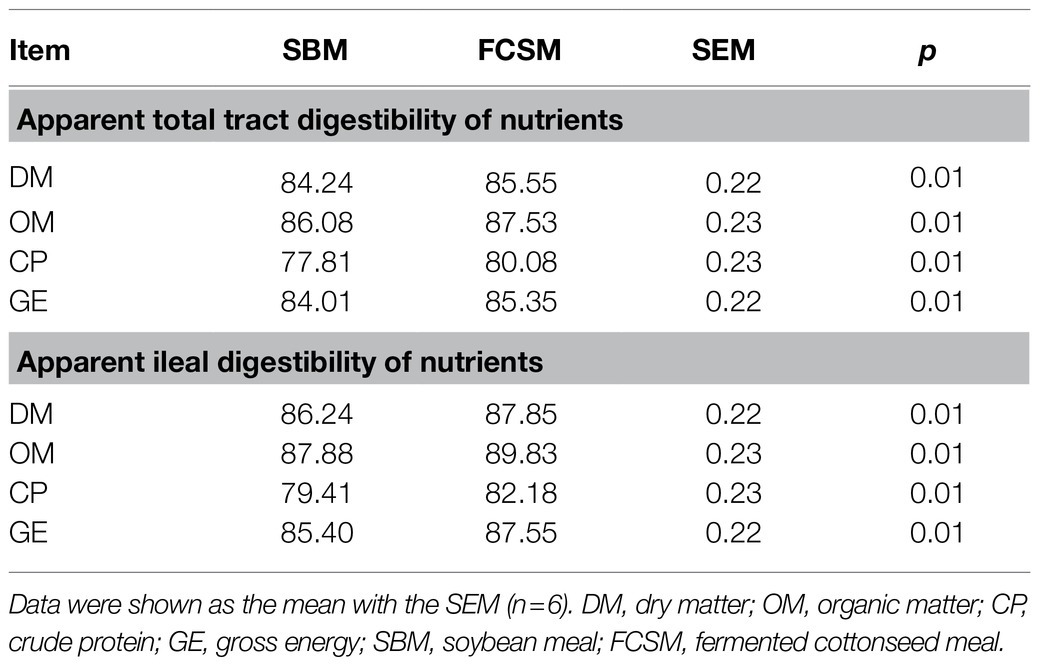
Table 4. Effects of two protein source on apparent total tract digestibility and ileal digestibility of nutrients of weaned piglets (%).
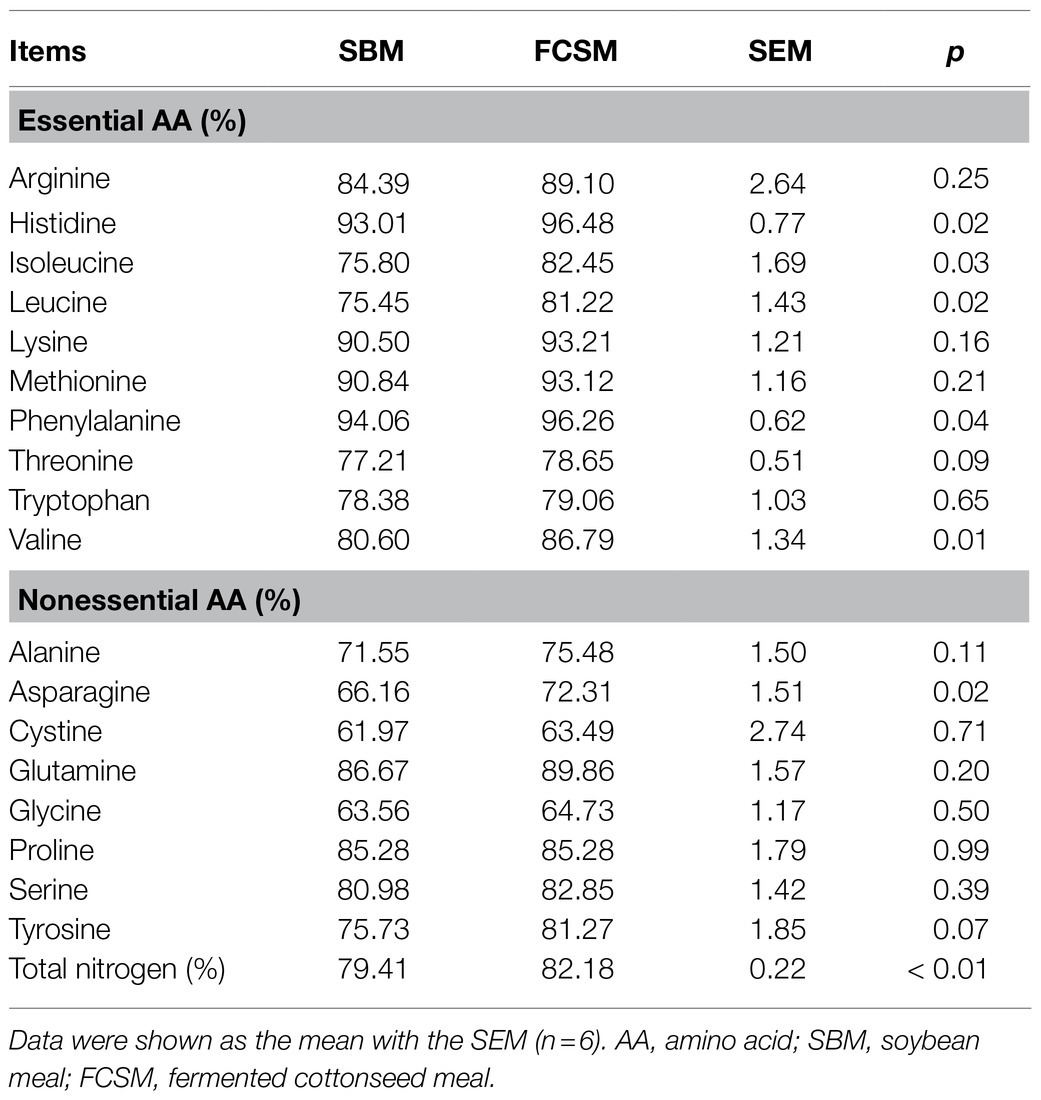
Table 5. Effects of two protein source on apparent ileal digestibility of amino acids and nitrogen of weaned piglets (%).
Immunity and Antioxidant Properties
The results have shown that piglets in the FCSM group had higher serum IgG (p<0.05) than those in the SBM group (Table 6). However, no significant difference was observed in terms of serum IgA and IgM (p>0.05) of weaned piglets between the two groups. The effects of FCSM and SBM on serum, intestine and liver antioxidant enzyme activity and oxidant products on weaned piglets has been shown in Table 7. Compared with the SBM group, the SOD and GSH-Px in serum, jejunum, and ileum were improved on the piglets in the FCSM group (p<0.05). Moreover, the jejunal T-AOC and the liver GSH-Px were enhanced on the piglets in the FCSM group (p<0.05). Furthermore, the serum MDA was reduced on the piglets in the FCSM group (p<0.05).
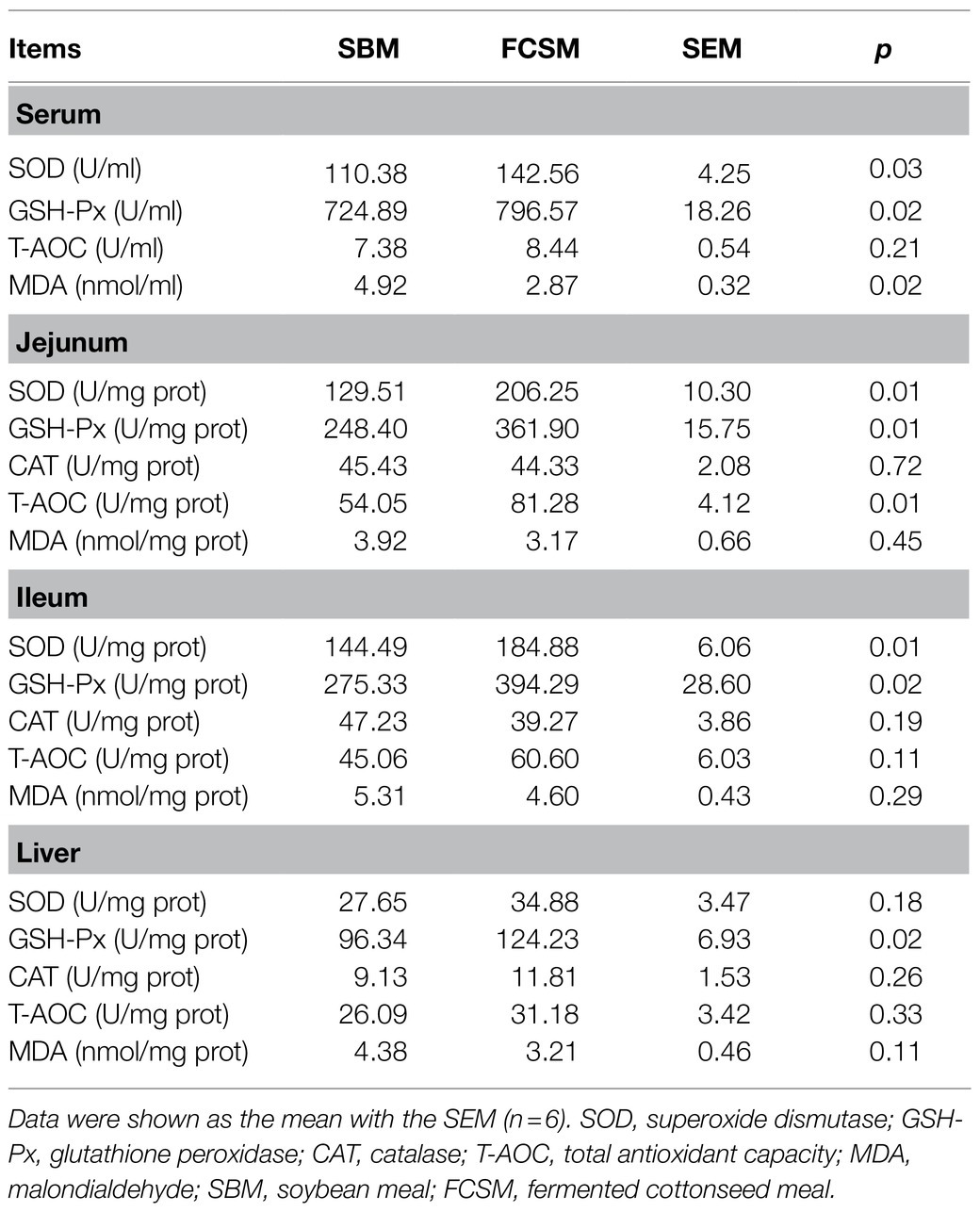
Table 7. Effects of two protein source on serumal, intestinal and hepatic antioxidant enzyme activity and oxidant products of weaned piglets.
VFAs Composition
The VFAs composition in ileal and cecal digesta of weaned piglets were obtained in Table 8. Compared with the SBM group, the concentration of acetate, propionate, butyrate, isobutyrate, isovalerate, and total VFAs in ileal digesta of weaned piglets were increased in the FCSM group (p<0.05). Similarly, the concentration of acetate, propionate, valerate, isobutyrate, isovalerate, and total VFAs in cecal digesta of weaned piglets were higher (p<0.05) and the concentration of butyrate had a tendency to increase in the FCSM group (0.05<p<0.1).
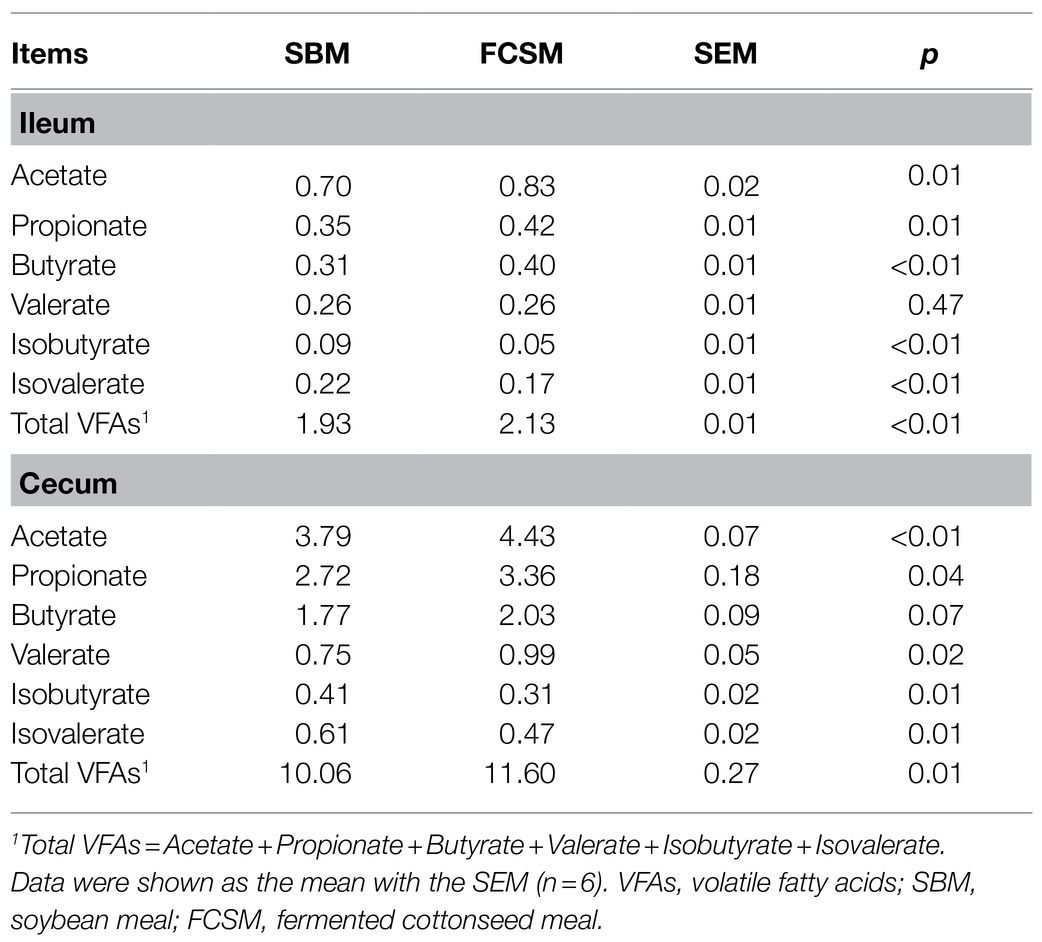
Table 8. Effects of protein source on volatile fatty acids composition in ileal and cecal digesta of weaned pigs (mg/g digesta).
Gut Microbiota Diversity
The OTUs of the ileal digesta from SBM and FCSM groups were 152 and 169, respectively, among which 82 common OTUs have been identified (Figure 1A). On the other hand, the OTUs of the cecal digesta from SBM and FCSM groups were 743 and 656, respectively, wherein 544 common OTUs have been identified (Figure 1B). The α-diversity of ileal and cecal microbiota including Simpson index and Chao1 index were presented in Figures 2A–D. The FCSM diet induced higher Simpson index of ileum than the SBM (p<0.05), whereas no difference was shown in the other index between the two dietary treatments neither in the ileum nor cecum (p>0.05). The β-diversity of bacterial community between SBM and FCSM was presented with PCoA (Figures 2E,F), showing a tendency of different clustering of microbial communities in cecum (0.05<p<0.1, Figure 2F).
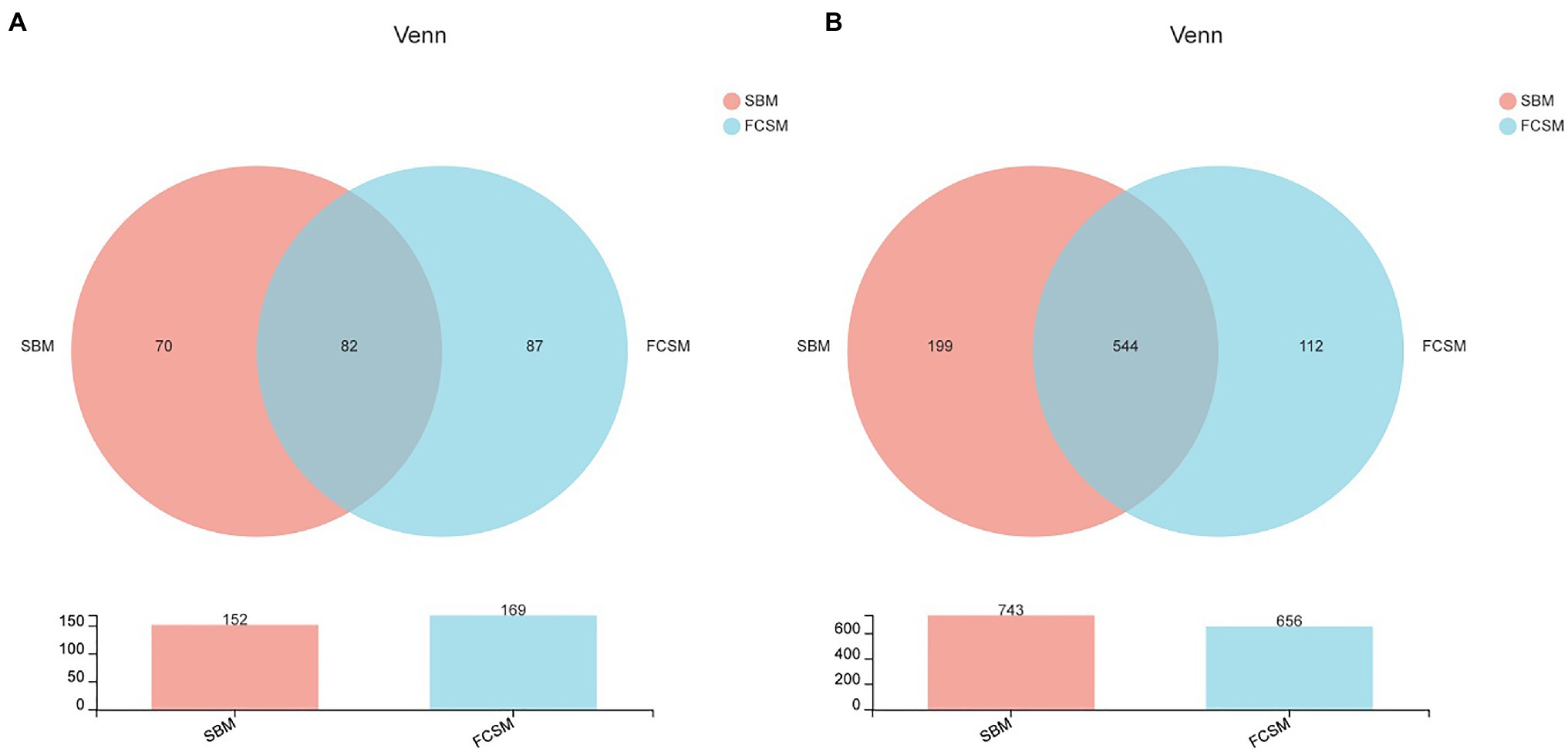
Figure 1. Effects of two protein sources on the ileac (A) and cecal (B) microbes at the operational taxonomic unit (OTU) in piglets. The individual minipig was regarded as the experimental unit (n=6). SBM, soybean meal; FCSM, fermented cottonseed meal.
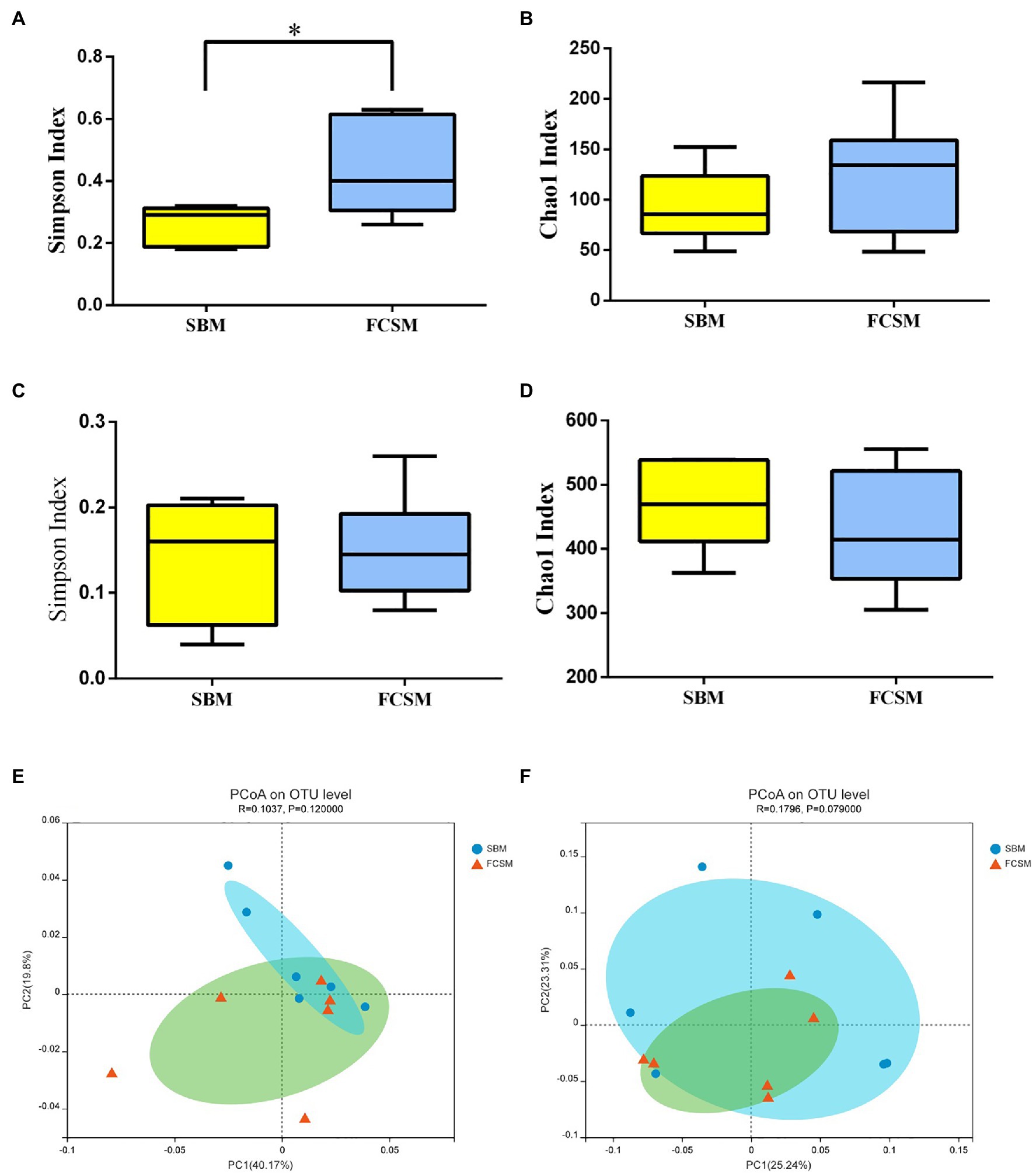
Figure 2. Effects of two protein sources on the α-diversity indexes including Simpson index of ileac (A) and cecal (C) microbes, Chao1 index of the ileac (B) and cecal (D) microbes, β-diversity of the ileac (E) and cecal (F) microbes in piglets. The individual minipig was regarded as the experimental unit (n=6). SBM, soybean meal; FCSM, fermented cottonseed meal. *p < 0.05.
At the phylum level, Firmicutes and Bacteroidetes were the dominant bacteria in both ileum and cecum. There was no difference found by the students’ tests in microbiota at the phylum level between the two treatment groups in ileum (p>0.05; Figure 3A). However, the proportion of cecal Proteobacteria was decreased (p<0.05) in the FCSM group compared with the SBM group (Figure 3C). Besides, at the genus level (Figures 3B,D), the proportion of ileal Lactobacillus was enhanced but the ileal unclassified_p_Firmicutes and cecal Ruminococcus_1 was decreased in the piglets in the FCSM group rather than that in the SBM group (p<0.05).
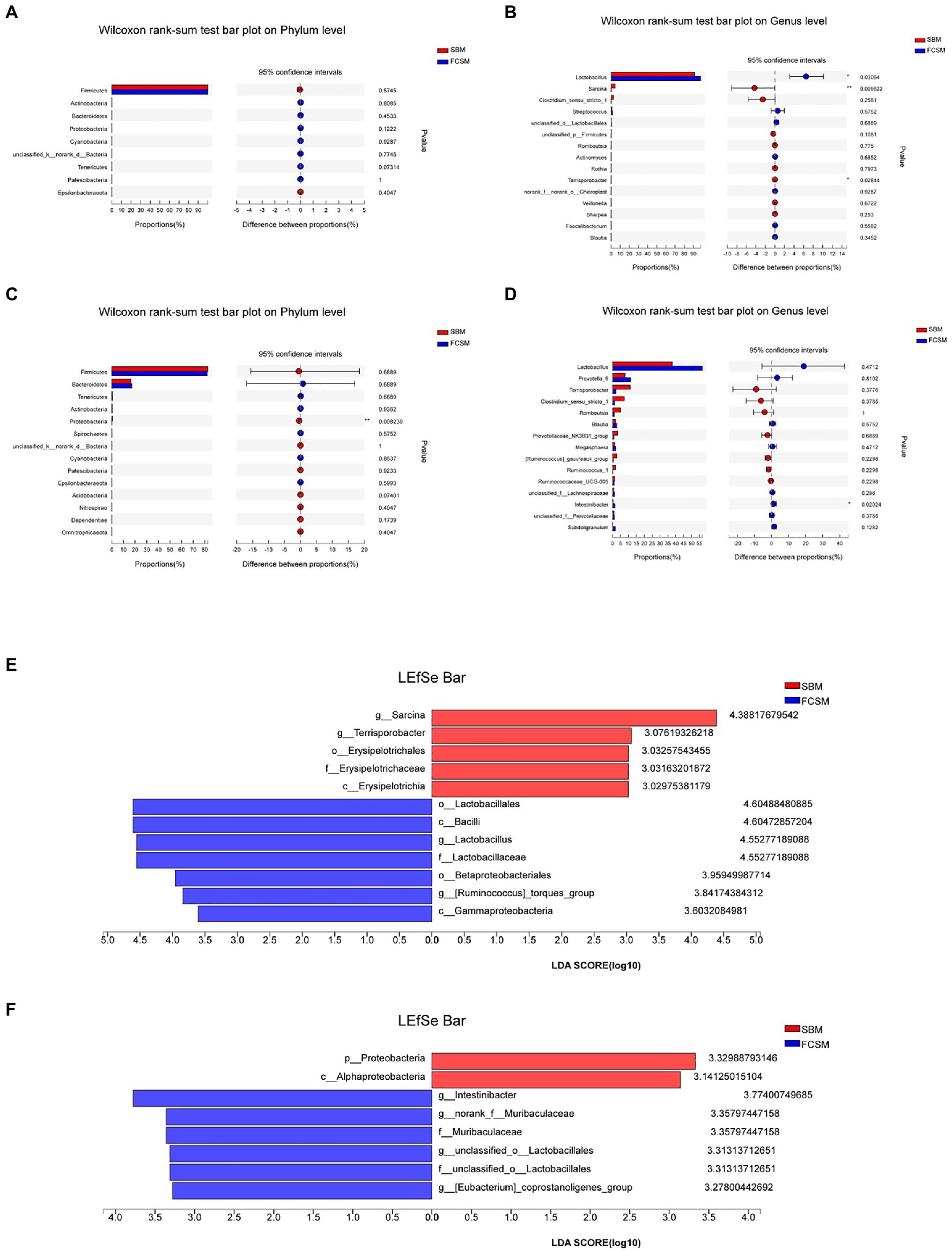
Figure 3. Different microbiota comparison by the student t-test on Phylum and Genus of ileum (A,B) and cecum (C,D) was shown in (A–D). LDA effect size analysis (LEfSe) analysis showed significantly changed bacteria between SBM and FCSM group in ileum (E) and cecum (F). The individual minipig was regarded as the experimental unit (n=6). SBM, soybean meal; FCSM, fermented cottonseed meal.
The LEfSe analysis was used to identify the significantly different bacteria in the ileum and cecum between the two treatment groups from the phylum to genus level (Figures 3E,F). The relative abundance of Lactobacillus and [Ruminococcus]_torques_group in ileum and Intestinibacter, norank_f_Muribaculaceae, unclassified_o_Lactobacillales and [Eubacterium]_coprostanoligenes_group in cecum were enhanced in piglets fed with the FCSM diet than those fed with SBM diet, whereas the relative abundance of Sarcina and Terrisporobacter in ileum were decreased in piglets fed with the FCSM diet.
Discussion
Cottonseed meal has not been widely used because it contains a large number of anti-nutritional factors, which result negative effects on growth performance, immune and antioxidant capacity and nutrient digestibility in animals (Nagalakshmi et al., 2007; Nie et al., 2015; Świątkiewicz, 2016). After going through solid state fermentation, FCSM has much less free gossypol and other anti-nutritional factors, and definitively improved protein quality (Zhang et al., 2006, 2007; Sun et al., 2014; Wang et al., 2017). Sun et al. (2013) reported that the appropriate inclusion of FCSM replacing SBM improved the growth of yellow-feathered broiler chickens. Similarly, FCSM supplementation improved the ADG and G:F ratio of yellow-feathered broilers from the 43rd to 64th and the 21st to 64th day, respectively (Nie et al., 2015), which indicated that FCSM is beneficial for broilers as it enhanced their growth performance and digestion. Consistently, the current study showed that the piglets in the FCSM group presented greater growth performance and a lower diarrhea rate than those in the SBM group. The fermentation process of CSM might be one of the reasons, which effectively decreases free gossypol level, and increases acid-soluble protein level in CSM, and therefore further improves the digestive enzyme activity and nutrient digestibility in weaned piglets (Sun et al., 2014; Wang et al., 2017). This explanation has been confirmed by the nutrient digestibility of weaned piglets in FCSM and SBM treatments. The present results demonstrated that the apparent total tract digestibility and ileal digestibility of nutrients, essential and nonessential AA have been enhanced in piglets within the FCSM group.
Moreover, the microbial fermentation process can produce many beneficial substances, such as small-size peptides, exoenzymes, vitamins, organic acids, which can promote the immunity of animals (Johnson, 2013; Zhao et al., 2016). A study have reported that fermentation with Bacillus subtilis BJ-1 can reduce free gossypol level in CSM and dietary inclusion of 12% FCSM can improve immunity (Tang et al., 2012). Wang et al. (2017) reported that the dietary supplementation of FCSM increased serum IgM and IgG levels compared with SBM groups in broilers. In the present study, the concentration of serumal IgG was increased in piglets in the FCSM group in comparison with those in the SBM group, which might be due to the live microbes in FCSM acting as probiotics to enhance the humoral immune response of the animals (Latesh et al., 2013; Stašová et al., 2015).
The immunity of piglets is highly related to antioxidant capacity (Liu et al., 2021). Besides, antioxidase can improve the immunity by promoting the bacterial clearance and regulates phagocyte numbers (Peterman et al., 2015). In addition, a microbial FCSM increased the antioxidant activity in diets for Nile tilapia (Lim and Lee, 2011). Similarly, the present study showed that the antioxidation-related enzymes in serum, jejunum, ileum and liver were improved in piglets in the FCSM group compared with that in the SBM group. Additionally, the serum MDA was reduced in piglets in the FCSM group, which indicated that FCSM improved the antioxidative abilities compared with SBM (Wang et al., 2017). This may be one of the reasons that the improvement of growth performance in piglets has found in the FCSM group (Ma, X. et al., 2019; Ma, X. K. et al., 2019).
Many studies suggest that food or feeds fermented by probiotics may be potentially an effective strategy to regulate the gut microbiota and its metabolites (Azad et al., 2020; Niu et al., 2020; Gu et al., 2021; Li et al., 2021). The VFAs, especially butyric acid, as a microbial metabolite, can not only improve the growth performance, but also boost the immunity of piglets (Fang et al., 2014; Zhao et al., 2018). Zhao et al. (2018) reported that dietary fiber increases the butyrate-producing bacteria and improves growth performance of weaned piglets. Tsai et al. (2019) discovered that feeding sodium butyrate during the nursery phase tended to alter blood cell count and improve growth performance of weaned pigs. In the present study, the VFAs of ileum and cecum were increased in the FCSM group than that in the SBM group. This may explain the improved growth performance of piglets. Moreover, VFAs, as important intermediate products during anaerobic digestion, may influence the fermentation characteristics of hindgut (Jha and Berrocoso, 2016; Seradj et al., 2018). The protein fermentation metabolites in the hindgut are amines, SCFAs and BCFAs, among which amines must be converted from nitrogen-containing groups, while BCFAs are only produced from the fermentation of three branched chain amino acids, leucine, isoleucine and valine (Jha and Berrocoso, 2016; Seradj et al., 2018). Over-fermentation of protein in the hindgut is an important cause of diarrhea in piglets. The current study found that FCSM replacing SBM decreased the isobutyrate and isovalerate of the cecum, suggesting that FCSM reduced hindgut fermentation, which may be responsible for the reduced diarrhea rate in piglets.
In recent years, the interaction and connections between dietary protein, gut microbe and host has received increasing attention. Segmented exogenous microbiota transplantation proved the spatial heterogeneity of bacterial colonization along the gastrointestinal tract, i.e., the microbiota from one specific location selectively colonizes its homologous gut region (Li et al., 2020). The number of microorganisms in the hindgut was higher than that in the foregut (Jamet et al., 2011), which is consistent with the result in the present study. It has been previously shown that FCSM enhanced the Simpson index of ileum in piglets, which has a great contribution towards the improvement of intestinal health and maturation in piglets (Wang, X. et al., 2019). Lower protein concentration or better protein sources in the diets can improve hindgut health by preventing the proliferation of pathogenic bacteria and reduced the risk of colitis (Vidal-Lletjós et al., 2017; Najafabadi et al., 2019). Studies have shown that protein fermentation can change the composition and function of intestinal flora (Lu et al., 2019; Wang, H. et al., 2019). Consistently, in the present study, the analysis of the PCoA has shown that the microbial composition between the SBM and FCSM groups are slightly different.
Firmicutes and Bacteroidetes were the most dominant phyla in the pig (Chen et al., 2017). In our study, Firmicutes is the most dominant phyla in ileum and Firmicutes and Bacteroidetes in cecum. Lactobacillus, as a potential probiotic, possesses the resistance to pathogen, anti-inflammatory and antioxidant capacity, and ability to improve of gut microbiota profile (He et al., 2019; Yang et al., 2020). Wang et al. (2017) has discovered that Lactobacilli and total anaerobic bacteria counts in ceca digesta of birds fed FCSM were improved compared with birds fed CSM on days 21 and 42. Likewise, the FCSM replacing the SBM has also enhanced the relative abundance of Lactobacillus of ileum and cecum in the present study. He et al. (2019) has found that Lactobacillus johnsonii L531 reduced pathogen load and helped maintain SCFA levels in the intestine of pigs challenged with Salmonella enterica Infantis. Therefore, this might be one of the reasons that piglets in the FCSM group had higher level of VFAs than that in the SBM group. On the other hand, proteobacteria is the largest phylum of bacteria, including many pathogenic bacteria, such as Escherichia coli, Salmonella, Vibrio cholerae, Helicobacter pylori and other well-known species. In the current study, the relative abundance of Proteobacteria was decreased in piglets in the FCSM group, suggesting that the FCSM has the potential function to inhibit harmful bacteria, and improves the gut microbiota profile than SBM (Wang et al., 2017). In conclusion, FCSM replacing SBM improved the growth performance, immunity and antioxidant properties, nutrients digestibility possibly via the altering gut microbiota profile and its metabolites in weaned piglets.
Data Availability Statement
The data presented in the study are deposited in the (NCBI SRA) repository, accession number (PRJNA743130).
Ethics Statement
The animal study was reviewed and approved by Animal Care and Use Ethics Committee of the Hunan Agricultural University.
Author Contributions
XG and XM: conceptualization, methodology, and software. ZL, NL, XL, and FZ: literature collection. XG and JW: writing–original draft preparation. JC, QJ, and BT: writing–reviewing and editing. XM: funding acquisition. All authors contributed to the article and approved the submitted version.
Funding
This review is funded by Scientific Research Fund of Hunan Provincial Education Department (19B267) and the Youth Science Foundation Project of Hunan Agricultural University (19QN01), and the Open Foundation of CAS Key Laboratory of Agro-ecological Processes in Subtropical Region, Institute of Subtropical Agriculture (ISA2020101).
Conflict of Interest
The authors declare that the research was conducted in the absence of any commercial or financial relationships that could be construed as a potential conflict of interest.
Publisher’s Note
All claims expressed in this article are solely those of the authors and do not necessarily represent those of their affiliated organizations, or those of the publisher, the editors and the reviewers. Any product that may be evaluated in this article, or claim that may be made by its manufacturer, is not guaranteed or endorsed by the publisher.
Abbreviations
BW, Body weight; ADG, Average daily gain; ADFI, Average daily feed intake; G:F, Gain to feed ratio; IgA, Immunoglobulin A; IgG, Immunoglobulin G; IgM, Immunoglobulin M; SOD, Superoxide dismutase; GSH-Px, Glutathione peroxidase; T-AOC, Total antioxidant capacity; MDA, Malondialdehyde; CAT, Catalase; AA, Amino acid; HPLC, High Performance Liquid Chromatography; AIA, Acid insoluble ash; AID, Apparent ileal digestibility; VFAs, Volatile fatty acids; SCFAs, Short chain fatty acids; BCFAs, Branched chain fatty acids; PCR, Polymerase chain reaction; OTUs, Operational taxonomic units; PCoA, Principal co-ordinates analysis; LDA, Linear discriminant analysis; LEfSe, Linear discriminant analysis effect size; PICRUSt, Phylogenetic investigation of communities by reconstruction of unobserved states.
Footnotes
References
Azad, M. A. K., Gao, J., Ma, J., Li, T., Tan, B., Huang, X., et al. (2020). Opportunities of prebiotics for the intestinal health of monogastric animals. Anim. Nutr. 6, 379–388. doi: 10.1016/j.aninu.2020.08.001
Azarm, H. M., and Lee, S. M. (2014). Effects of partial substitution of dietary fish meal by fermented soybean meal on growth performance, amino acid and biochemical parameters of juvenile black sea bream acanthopagrus schlegeli. Aquac. Res. 45, 994–1003. doi: 10.1111/are.12040
Chen, L., Xu, Y., Chen, X., Fang, C., Zhao, L., and Chen, F. (2017). The maturing development of gut microbiota in commercial piglets during the weaning transition. Front. Microbiol. 8:1688. doi: 10.3389/fmicb.2017.01688
Fang, C. L., Sun, H., Wu, J., Niu, H. H., and Feng, J. (2014). Effects of sodium butyrate on growth performance, haematological and immunological characteristics of weanling piglets. J. Anim. Physiol. An. N. 98, 680–685. doi: 10.1111/jpn.12122
Gu, X. L., Chen, J., Li, H., Song, Z. H., Chang, L., He, X., et al. (2021). Isomaltooligosaccharide and bacillus regulate the duration of farrowing and weaning-estrous interval in sows during the perinatal period by changing the gut microbiota of sows. Anim. Nutr. 7, 72–83. doi: 10.1016/j.aninu.2020.06.010
Guan, H., Wang, J., Zhang, D., Ma, J., and Zheng, W. (2017). Effects of fermented cottonseed meal on production performance and health status of nursery pig, growing pig and finishing pig. Swine Production 4, 9–11. doi: 10.13257/j.cnki.21-1104/s.2017.04.003
He, T., Zhu, Y. H., Yu, J., Xia, B., Liu, X., Yang, G. Y., et al. (2019). Lactobacillus johnsonii L531 reduces pathogen load and helps maintain short-chain fatty acid levels in the intestines of pigs challenged with salmonella enterica Infantis. Vet. Microbiol. 230, 187–194. doi: 10.1016/j.vetmic.2019.02.003
Jamet, A., Mérieux, A., Cultrone, A., Torrejon, A., Cara, C., Friss, C., et al. (2011). Enterotypes of the human gut microbiome. Nature 473, 174–180. doi: 10.1038/nature09944
Jha, R., and Berrocoso, J. F. D. (2016). Dietary fiber and protein fermentation in the intestine of swine and their interactive effects on gut health and on the environment: a review. Anim. Feed Sci. Technol. 212, 18–26. doi: 10.1016/j.anifeedsci.2015.12.002
Johnson, E. A. (2013). Biotechnology of non-saccharomyces yeasts-the basidiomycetes. Appl. Microbiol. Biotechnol. 97, 503–517. doi: 10.1007/s00253-012-4497-y
Keulen, J. V., and Young, B. A. (1977). Evaluation of acid-insoluble ash as a natural marker in ruminant digestibility studies. J. Anim. Sci. 44, 282–287. doi: 10.2527/jas1977.442282x
Kim, S. W. (2014). Identification of a second major antigenic epitope in the α-subunit of soy β-conglycinin. Food Agric. Immunol. 25, 311–321. doi: 10.1080/09540105.2013.791969
Latesh, K., Singh, P. K., and Manoj, K. (2013). Effect of dietary supplementation of combination of probiotics on the growth performance and immune response of broiler chickens. Anim. Nutr. Feed. Technol. 13, 15–25. doi: 10.1080/09064702.2013.877520
Li, H., Yin, J., He, X., Li, Z., Tan, B., Jiang, Q., et al. (2021). Enzyme-treated soybean meal replacing extruded full-fat soybean affects nitrogen digestibility, cecal fermentation characteristics and bacterial community of newly weaned piglets. Front. Vet. Sci. 8:639039. doi: 10.3389/fvets.2021.639039
Li, N., Zuo, B., Huang, S., Zeng, B., and Wang, J. (2020). Spatial heterogeneity of bacterial colonization across different gut segments following inter-species microbiota transplantation. Microbiome 8:161. doi: 10.1186/s40168-020-00917-7
Lim, S., and Lee, K. (2011). A microbial fermentation of soybean and cottonseed meal increases antioxidant activity and gossypol detoxification in diets for Nile tilapia, Oreochromis niloticus. J. World Aquacult. Soc. 42, 494–503. doi: 10.1111/j.1749-7345.2011.00491.x
Liu, L., Chen, D., Yu, B., Luo, Y., and He, H. (2021). Influences of selenium-enriched yeast on growth performance, immune function, and antioxidant capacity in weaned pigs exposure to oxidative stress. Biomed. Res. Int. 2021:5533210. doi: 10.1155/2021/5533210
Lordelo, M. M., Calhoun, M. C., Dale, N. M., Dowd, M. K., and Davis, A. J. (2007). Relative toxicity of gossypol enantiomers in laying and broiler breeder hens. Poult. Sci. 86, 582–590. doi: 10.1093/ps/86.3.582
Lu, J., Zhang, X., Liu, Y., Cao, H., and Shi, X. (2019). Effect of fermented corn-soybean meal on serum immunity, the expression of genes related to gut immunity, gut microbiota, and bacterial metabolites in grower-finisher pigs. Front. Microbiol. 10:2620. doi: 10.3389/fmicb.2019.02620
Ma, X., Shang, Q., Hu, J., Liu, H., Brøkner, C., and Piao, X. (2019). Effects of replacing soybean meal, soy protein concentrate, fermented soybean meal or fish meal with enzyme-treated soybean meal on growth performance, nutrient digestibility, antioxidant capacity, immunity and intestinal morphology in weaned pigs. Livest. Sci. 225, 39–46. doi: 10.1016/j.livsci.2019.04.016
Ma, X. K., Shang, Q. H., Wang, Q. Q., Hu, J. X., and Piao, X. S. (2019). Comparative effects of enzymolytic soybean meal and antibiotics in diets on growth performance, antioxidant capacity, immunity, and intestinal barrier function in weaned pigs. Anim. Feed Sci. Technol. 248, 47–58. doi: 10.1016/j.anifeedsci.2018.12.003
Nagalakshmi, D., Rao, S. V. R., Panda, A. K., and Sastry, V. R. B. (2007). Cottonseed meal in poultry diets: a review. J. Poult. Sci. 44, 119–134. doi: 10.2141/jpsa.44.119
Najafabadi, Z. S., Nielsen, T. S., and Hedemann, M. S. (2019). Dietary protein source and butyrylated high-amylose maize starch included in a high-protein diet determines the urinary metabolome of rats. Int. J. Food Sci. Nutr. 70, 255–266. doi: 10.1080/09637486.2018.1499711
Nie, C., Zhang, W., Wenxia, G. E., Wang, Y., Liu, Y., and Liu, J. (2015). Effects of fermented cottonseed meal on the growth performance, apparent digestibility, carcass traits, and meat composition in yellow-feathered broilers. Turk. J. V. Anim. Sci. 39, 350–356. doi: 10.3906/vet-1410-65
Niu, J. L., Zhang, J., Wei, L. Q., Ma, X., Zhang, W. J., and Nie, C. X. (2020). Cottonseed meal fermented by Candida tropical reduces the fat deposition in white-feather broilers through cecum bacteria-host metabolic cross-talk. Appl. Microbiol. Biotechnol. 104, 4345–4357. doi: 10.1007/s00253-020-10538-7
Peterman, E. M., Sullivan, C., Goody, M. F., Rodriguez-Nunez, I., Yoder, J. A., and Kim, C. H. (2015). Neutralization of mitochondrial superoxide by superoxide dismutase 2 promotes bacterial clearance and regulates phagocyte numbers in zebrafish. Infect. Immun. 83, 430–440. doi: 10.1128/IAI.02245-14
Seradj, A. R., Balcells, J., Morazan, H., Alvarez-Rodriguez, J., Babot, D., and De la Fuente, G. (2018). The impact of reducing dietary crude protein and increasing total dietary fiber on hindgut fermentation, the methanogen community and gas emission in growing pigs. Anim. Feed Sci. Technol. 245, 54–66. doi: 10.1016/j.anifeedsci.2018.09.005
Stašová, D., Husáková, E., Bobíková, K., Karaffová, V., Levkutová, M., and Levkut, M. (2015). Expression of cytokines in chicken peripheral blood mononuclear cells after stimulation by probiotic bacteria and campylobacter jejuni in vitro. Food Agric. Immunol. 26, 813–820. doi: 10.1080/09540105.2015.1036356
Stein, H. H., Fuller, M. F., Moughan, P. J., Sève, B., Mosenthin, R., Jansman, A. J. M., et al. (2007). Definition of apparent, true, and standardized ileal digestibility of amino acids in pigs. Livest. Sci. 109, 282–285. doi: 10.1016/j.livsci.2007.01.019
Sun, H., Tang, J., Yao, X., Wu, Y., Wang, X., and Feng, J. (2013). Effects of dietary inclusion of fermented cottonseed meal on growth, cecal microbial population, small intestinal morphology, and digestive enzyme activity of broilers. Trop. Anim. Health Prod. 45, 987–993. doi: 10.1007/s11250-012-0322-y
Sun, H., Yao, X., Wang, X., Wu, Y., Liu, Y., Tang, J., et al. (2014). Chemical composition and in vitro antioxidant property of peptides produced from cottonseed meal by solid-state fermentation. CYTA J. Food 13, 264–272. doi: 10.1080/19476337.2014.948072
Świątkiewicz, S. (2016). The use of cottonseed meal as a protein source for poultry: an updated review. Worlds Poult. Sci. J. 72, 473–484. doi: 10.1017/S0043933916000258
Tang, J. W., Sun, H., Yao, X. H., Wu, Y. F., Wang, X., and Feng, J. (2012). Effects of replacement of soybean meal by fermented cottonseed meal on growth performance, serum biochemical parameters and immune function of yellow-feathered broilers. Asian Aust. J. Anim. Sci. 25, 393–400. doi: 10.5713/ajas.2011.11381
Tsai, T. C., Stein, H. H., Bradley, C. L., Blavi, L., Bottoms, K., Knapp, J., et al. (2019). Effect of sodium butyrate (SB) on growth performance and complete blood cell count in nursery pigs: two facility study. J. Anim. Sci. 97, 76–77. doi: 10.1093/jas/skz122.141
Vidal-Lletjós, S., Beaumont, M., Tomé, D., Benamouzig, R., Blachier, F., and Lan, A. (2017). Dietary protein and amino acid supplementation in inflammatory bowel disease course: what impact on the colonic mucosa. Nutrients 9:310. doi: 10.3390/nu9030310
Wang, Y., Deng, Q., Song, D., Wang, W., Zhou, H., Wang, L., et al. (2017). Effects of fermented cottonseed meal on growth performance, serum biochemical parameters, immune functions, antioxidative abilities, and cecal microflora in broilers. Food Agric. Immunol. 28, 725–738. doi: 10.1080/09540105.2017.1311308
Wang, H., Shen, J., Pi, Y., Gao, K., and Zhu, W. (2019). Low-protein diets supplemented with casein hydrolysate favor the microbiota and enhance the mucosal humoral immunity in the colon of pigs. J. Anim. Sci. Biotechnol. 10:79. doi: 10.1186/s40104-019-0387-9
Wang, X., Tsai, T., Deng, F., Wei, X., and Zhao, J. (2019). Longitudinal investigation of the swine gut microbiome from birth to market reveals stage and growth performance associated bacteria. Microbiome 7:109. doi: 10.1186/s40168-019-0721-7
Yang, G. Y., Xia, B., Su, J. H., He, T., Liu, X., Guo, L., et al. (2020). Anti-inflammatory effects of Lactobacillus johnsonii L531 in a pig model of Salmonella Infantis infection involves modulation of CCR6 + T cell responses and ER stress. Vet. Res. 51, 26–39. doi: 10.1186/s13567-020-00754-4
Zhang, W. J., Xu, Z. R., Sun, J. Y., and Yang, X. (2006). Effect of selected fungi on the reduction of gossypol levels and nutritional value during solid substrate fermentation of cottonseed meal. J. Zhejiang Univ. Sci. B 7, 690–695. doi: 10.1631/jzus.2006.B0690
Zhang, W. J., Xu, Z. R., Zhao, S. H., Sun, J. Y., and Yang, X. (2007). Development of a microbial fermentation process for detoxification of gossypol in cottonseed meal. Anim. Feed Sci. Technol. 135, 176–186. doi: 10.1016/j.anifeedsci.2006.06.003
Zhao, J., Ping, L., Wu, Y., Guo, P., Liu, L., Ma, N., et al. (2018). Dietary fiber increases the butyrate-producing bacteria and improves growth performance of weaned piglets. J. Agric. Food Chem. 66, 7995–8004. doi: 10.1021/acs.jafc.8b02545
Keywords: fermented cottonseed meal, growth performance, immunity and antioxidant capacity, gut microbiota, weaned piglets
Citation: Gu X, Li Z, Wang J, Chen J, Jiang Q, Liu N, Liu X, Zhang F, Tan B, Li H and Ma X (2021) Fermented Cottonseed Meal as a Partial Replacement for Soybean Meal Could Improve the Growth Performance, Immunity and Antioxidant Properties, and Nutrient Digestibility by Altering the Gut Microbiota Profile of Weaned Piglets. Front. Microbiol. 12:734389. doi: 10.3389/fmicb.2021.734389
Edited by:
Zheng Ruan, Nanchang University, ChinaReviewed by:
Yehui Duan, Institute of Subtropical Agriculture, Chinese Academy of Sciences (CAS), ChinaShihai Zhang, South China Agricultural University, China
Shad Mahfuz, Sylhet Agricultural University, Bangladesh
Copyright © 2021 Gu, Li, Wang, Chen, Jiang, Liu, Liu, Zhang, Tan, Li and Ma. This is an open-access article distributed under the terms of the Creative Commons Attribution License (CC BY). The use, distribution or reproduction in other forums is permitted, provided the original author(s) and the copyright owner(s) are credited and that the original publication in this journal is cited, in accordance with accepted academic practice. No use, distribution or reproduction is permitted which does not comply with these terms.
*Correspondence: Xiaokang Ma, bWF4aWFva2FuZ0BodW5hdS5lZHUuY24=
 Xueling Gu
Xueling Gu Zhiqing Li
Zhiqing Li Hao Li
Hao Li Xiaokang Ma
Xiaokang Ma